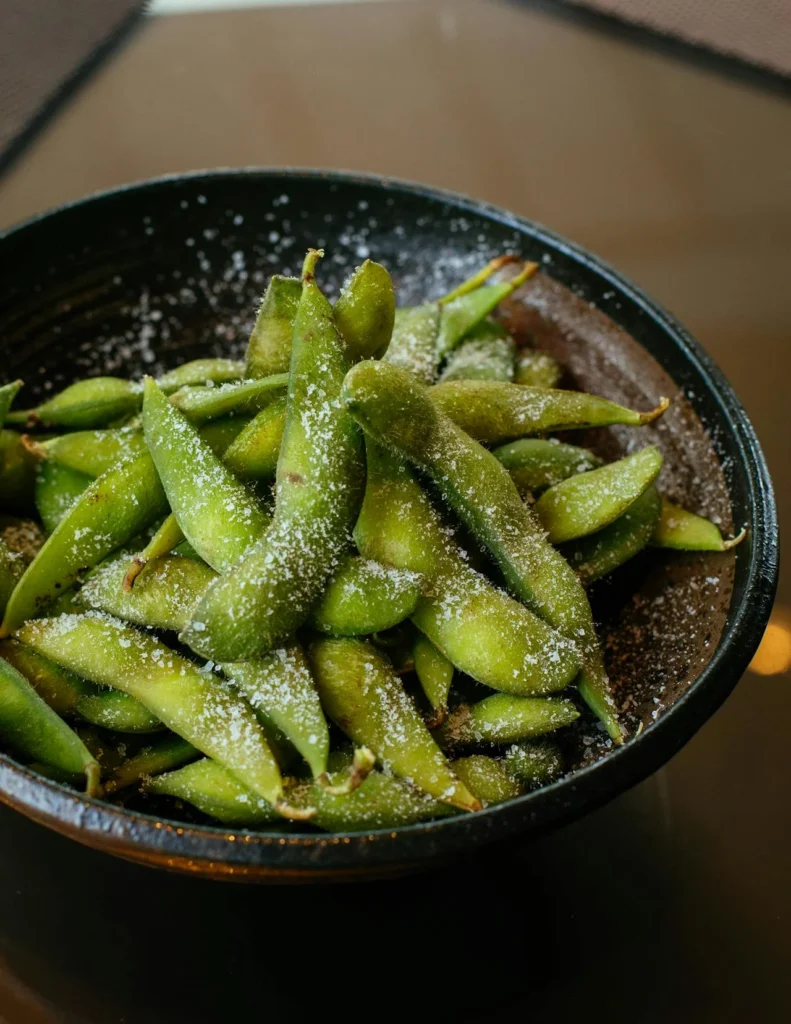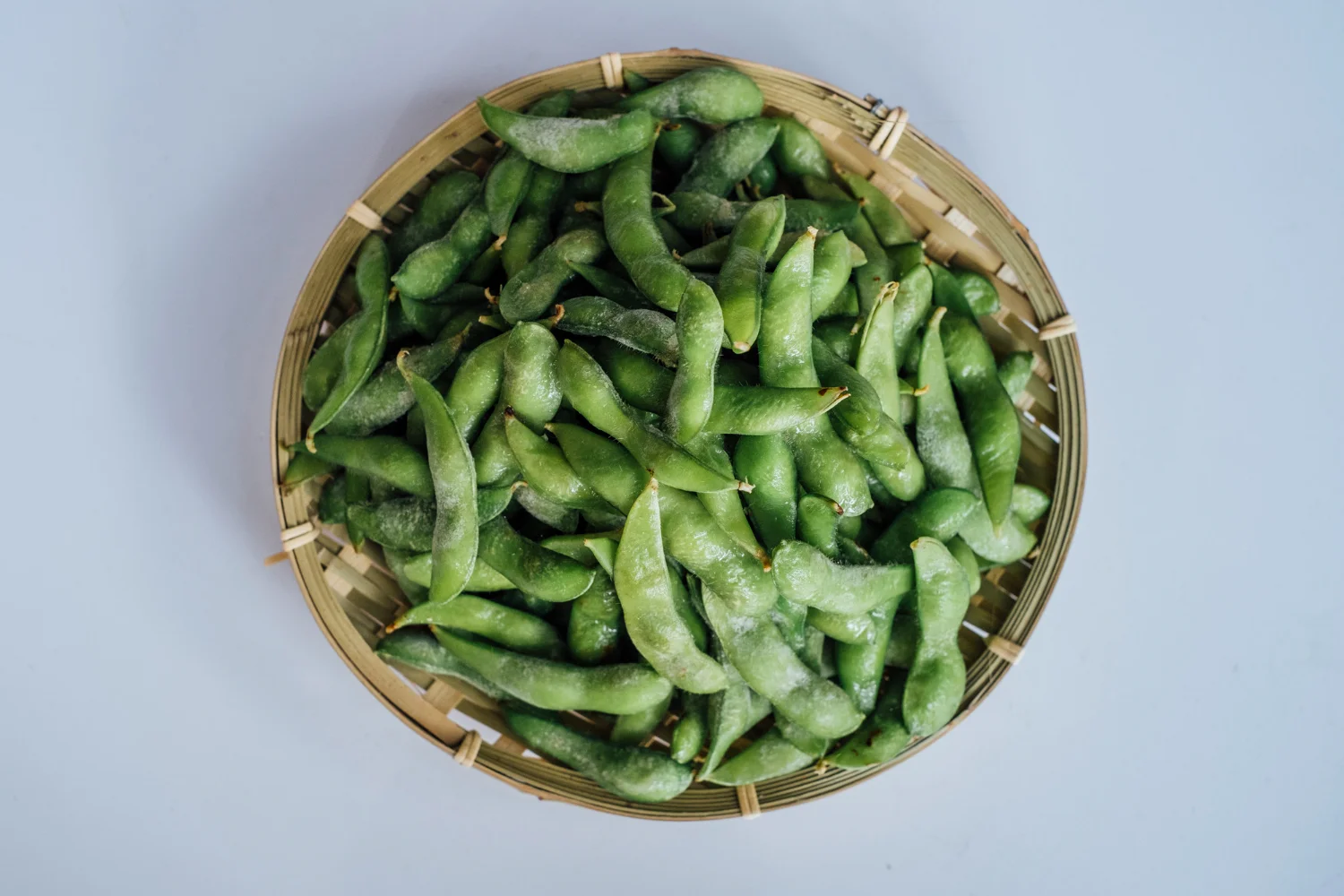Mukimame vs Edamame: What is the Difference? Read Here
Mukimame and edamame are essentially the same bean, both derived from immature soybeans that are picked before they fully ripen. This early harvest is what gives them their signature greener hue and sweeter, more delicate flavor compared to mature soybeans. However, while often used interchangeably, there is a subtle distinction: “edamame” typically refers to the whole pod, while “mukimame” denotes the shelled beans themselves.
This mild, buttery flavor has made edamame a beloved staple in Asian countries for centuries, and they’re now rapidly gaining popularity in non-Asian regions as well. Their culinary versatility, nutritional value, and delightful taste are winning over palates worldwide.
Note: Mukimame is pronounced as “moo-kee-mah-meh” and edamame is pronounced as “eh-duh-mah-meh.”
Contents
- Mukimame vs Edamame
- Mukimame vs Edamame Comparison Table
- What Does Edamame Taste Like?
- Nutrition Facts for Shelled Edamame (Mukimame)
- Health Benefits of Edamame/Mukimame
- How to Cook and Eat Mukimame/Edamame
- Characteristic
- Storing Edamame And Mukimame
- Can You Freeze Edamame And Mukimame?
- Buying and Choosing Edamame
- Potential Concerns and Considerations
- Mukimame vs Edamame FAQ
- How many carbs are in edamame?
- Is edamame keto?
- Is edamame gluten free?
- Is edamame FODMAP friendly?
- Do edamame and mukimame require the same cooking time?
- Can edamame be eaten with the shell?
- Can mukimame replace peas or green beans?
- Are mukimame beans the same as edamame?
- What’s the difference between edamame and soybeans?
- Can I eat edamame raw?
- What are some creative ways to use edamame in recipes?
- Are there any potential side effects of eating edamame?
Mukimame vs Edamame
Edamame is the name for the whole pod, which is inedible. Mukimame, on the other hand, refers to the shelled beans that are ready to eat. They are, in essence, the same plant at different stages of preparation.
You can buy edamame still in the pods or already shelled as mukimame. The naming can be confusing, as much of the mukimame sold in the U.S. is labeled as “edamame.” To clarify, I’ll refer to them as “edamame in the pod” and “shelled edamame” in this article.
Most retailers in the U.S. sell edamame in the pod and shelled edamame in the frozen section. However, you can sometimes find them fresh at Asian or specialty markets. Trader Joe’s, for instance, often carries fresh shelled edamame in their refrigerated section.
READ: Can You Freeze Risotto
Mukimame vs Edamame Comparison Table
| Feature | Mukimame | Edamame |
| Definition | Shelled beans, ready to eat | Whole pod, inedible pod |
| Preparation | Pre-shelled | Requires shelling before eating |
| Availability | Frozen or fresh (specialty markets) | Frozen or fresh (specialty markets) |
| Common Labeling in U.S. | Often labeled as “edamame” | Usually labeled as “edamame” |
What Does Edamame Taste Like?
Edamame has a flavor that’s a cross between a pea and green beans. It’s a little sweet, slightly nutty, and has a mild, vegetal flavor, balanced with a hint of salt in the background.
The pods can be enjoyed in several ways. Steaming or boiling is a popular choice, as it tames any grass-like notes and brings out the vegetable’s deliciously earthy, pea-like flavors. Adding a sprinkle of kosher salt or black pepper on top can enhance the taste.
Mixed into vegetables and cooked or pan-fried, edamame take on mild, buttery undertones. The type of oil you use can greatly affect the flavor. Sesame oil, for instance, adds a nutty depth.
The traditional way of serving edamame is to steam them and serve them with a dash of salt on the side. You can dip the individual beans in the salt as you eat them. This is a simple yet satisfying way to enjoy their natural flavor.
Nutrition Facts for Shelled Edamame (Mukimame)
Shelled edamame, or mukimame, are a nutritional powerhouse. A 1-cup (155g) serving of shelled edamame contains:
| Nutrient | Amount | DV |
| Calories | 189 | |
| Protein | 16.9g | |
| Total fat | 8.1g | |
| Carbohydrates | 15.8g | |
| Dietary Fiber | 8.1g | 32% |
| Vitamin K | 52% | |
| Folate | 121% | |
| Calcium | 10% | |
| Manganese | 79% | |
| Iron | 20% |
Shelled edamame beans, like other legumes, have a unique nutritional profile. They’re different from other carbohydrates because they contain higher quality protein. They’re a complete protein, meaning they provide all of the body’s essential amino acids, which are the building blocks of proteins required for normal health. This makes them a particularly beneficial food for vegetarians and vegans, as many plant-based sources of protein are incomplete.
READ: How to Know if Kale is Bad
Edamame is also a good source of healthy fats, fiber, vitamin K, folate, calcium, iron, and manganese. They contain soy isoflavones, a type of antioxidant that can help fight free radicals and oxidative stress in the body. Moreover, they are gluten-free, making them suitable for people with celiac disease.
In addition to all these nutrients, edamame is rich in prebiotics, which are a type of fiber that feed the beneficial bacteria in your gut. If you’re looking to add more prebiotic-rich foods to your diet, shelled edamame is a great option. You can find a printable list of prebiotic-rich foods online.


Health Benefits of Edamame/Mukimame
Lowering Cholesterol and Blood Pressure
Consuming soy protein instead of animal protein may reduce total cholesterol, LDL (“bad”) cholesterol, and raise HDL (“good”) cholesterol. A 2021 study found that consuming soy protein directly lowers circulating cholesterol and modestly lowers blood pressure. Read here about this study.
Reducing Cancer Risk
The American Cancer Society notes that there is growing evidence that eating traditional soy foods like tofu, tempeh, edamame, miso, and soymilk may lower the risk of breast cancer in Asian women and men. Research has also associated soy consumption with a reduction in prostate cancer risk when part of a healthy diet with fruits, vegetables, and whole grains.
Improving Bone Health
The soy isoflavones in edamame may improve bone strength and help prevent postmenopausal osteoporosis in women. A 2020 research study concluded that dietary patterns that include regular consumption of soy foods provide evidence that soy is useful for optimal bone health and is an integral part of a whole-foods, plant-based diet. Read here about this study.
How to Cook and Eat Mukimame/Edamame
Edamame is incredibly versatile and easy to prepare. You can cook both the pods and shelled beans in a variety of ways. Here are a few methods to try:
- Boiling: Boil the frozen edamame or mukimame in salted water for 3-5 minutes. Serve them hot or cold with a sprinkle of coarse salt.
- Steaming: Steam the edamame in a covered pot for 5-10 minutes. This is a great way to preserve their vibrant green color and delicate flavor.
- Microwaving: Place the frozen edamame or mukimame in a microwave-safe dish, cover with water, and microwave on high for 2-3 minutes. Season as desired with salt, pepper, or other seasonings.
- Sautéing: Heat some oil in a skillet over medium heat. Sauté the shelled edamame for a few minutes, stirring occasionally. You can add garlic, ginger, or other aromatics for extra flavor.
- Roasting: Thaw and drain the frozen edamame or mukimame. Toss them with olive oil, salt, pepper, and Parmesan cheese. Roast in a preheated oven at 400°F (200°C) for 10-15 minutes.
- Air Frying: If you have an air fryer, you can easily make a delicious garlic Parmesan air fryer edamame recipe. This is a quick and healthy snack option.
No matter how you prepare them, edamame is a delicious and nutritious addition to any meal.
To eat edamame in the pod, simply slide your teeth along the pod and pop the beans into your mouth, discarding the empty pod. This is a fun and engaging way to enjoy edamame, especially for kids. Shelled edamame, or mukimame, can be used as a side dish, protein alternative, snack, or ingredient in soups, salads, stir-fries, noodle dishes, or rice dishes.
Characteristic
| Characteristic | Edamame | Mukimame |
| Appearance | Resembles pea pods | Slightly flattened, wide beans |
| Dimensions | Pods typically hold 2-3 beans | Beans measure 0.8 to 1.2 cm |
| Taste | Mildly sweet with earthy notes | Mildly sweet with earthy notes |
| Culinary Uses | Tofu, salads, wraps, stir-fries, dips, etc. | Tofu, salads, wraps, stir-fries, dips, etc. |
| Cooking Method | Boil for 5 minutes | Boil for 5 minutes |
| Place of Origin | Asia (China and Japan) | Asia (China and Japan) |
| Nutritional Value (per cup) | 188 calories, 8g fat, 13.8g carbs, 18g protein, 8g fiber | 188 calories, 8g fat, 13.8g carbs, 18g protein, 8g fiber |
Storing Edamame And Mukimame
Edamame and mukimame can be stored in the same way. Uncooked beans should be removed from their original packaging and moved to an airtight container in the refrigerator, where they will keep for 3-4 days. Cooked edamame should be consumed within 2-3 days.
I recommend consuming these beans on the same day for the best flavor and texture. However, both edamame and mukimame can also be frozen. If you have extra cooked or uncooked beans, move them to an airtight container or a freezer-safe bag. Store them with your other frozen vegetables for 2-3 months.
If you plan to use the frozen beans directly in a recipe, there’s no need to thaw them first. However, if you want to enjoy them as a snack, you can thaw them using one of these methods:
- Room Temperature: Let the beans sit at room temperature for a few hours.
- Microwave: Use the lowest power setting or the “thaw” setting if your microwave has one. Higher power outputs may result in the beans getting cooked, which you don’t want if you plan to cook them further in a recipe.
Can You Freeze Edamame And Mukimame?
Yes, absolutely! Freezing is an excellent way to extend the shelf life of both edamame and mukimame. To freeze edamame in the pod, simply blanch them for a few minutes, then plunge them into ice water to stop the cooking process. Pat them dry and place them in a freezer-safe bag or airtight container.
For mukimame, or shelled edamame, no blanching is necessary. Just spread the beans on a baking sheet and freeze for a few hours until solid. Then, transfer them to a freezer-safe bag or container. Frozen edamame and mukimame can last for up to 8 months while maintaining their flavor and nutrients.
Buying and Choosing Edamame
When selecting edamame, the goal is to find pods that are vibrant, plump, and free of blemishes. Here’s what to look for:
Fresh Edamame (in Pods):
- Color: Look for bright green pods. Avoid those that are yellowing or browning, as this indicates they’re past their prime.
- Texture: The pods should feel firm and slightly fuzzy. If they’re limp or wrinkled, they’re likely old.
- Size: Choose pods that are plump and filled with beans. Gently squeeze them to check for fullness.
- Smell: Fresh edamame has a slightly sweet, grassy aroma. Avoid pods with a sour or unpleasant smell.
Frozen Edamame (in Pods or Shelled):
- Appearance: Check the bag for ice crystals. A small amount is normal, but excessive ice can indicate the edamame has been thawed and refrozen, which affects quality.
- Ingredients: Choose brands that list only edamame (or soybeans) on the ingredient list. Avoid those with added salt or other additives.
- Shelled Edamame (Mukimame): Look for bright green, plump beans. Avoid those that are dull in color or shriveled.
No matter which type you choose, trust your senses. Fresh edamame should look and smell vibrant, while frozen edamame should be free of excessive ice and have a clean ingredient list.
Potential Concerns and Considerations
While edamame offers numerous health benefits, it’s important to address potential concerns associated with soy consumption:
1. Genetically Modified Organisms (GMOs)
A significant portion of soybeans grown worldwide, including those used for edamame, are genetically modified. If you prefer to avoid GMOs, look for edamame products that are certified organic or explicitly labeled as non-GMO.
2. Soy Allergies
Soy is a common allergen, and those with soy allergies should avoid edamame in all forms. Allergic reactions can range from mild symptoms like hives or itching to severe reactions like anaphylaxis. If you experience any adverse reactions after consuming edamame, seek medical attention immediately.
3. Hormonal Effects
Soy contains isoflavones, which are naturally occurring plant compounds that have weak estrogen-like effects. While some studies suggest potential benefits for menopausal symptoms and bone health, others raise concerns about potential negative effects on hormone-sensitive conditions. If you have any concerns about soy’s hormonal effects, consult with your healthcare provider.
Making Informed Choices:
- Read labels carefully to identify organic or non-GMO edamame products.
- Consult with your doctor if you have any concerns about soy allergies or hormonal effects.
- Choose reputable brands that prioritize quality and transparency in their sourcing and production practices.
- Incorporate edamame as part of a balanced and varied diet, rather than relying on it as a sole source of protein or nutrients.
By being aware of these potential concerns and making informed choices, you can enjoy the many benefits of edamame while minimizing any potential risks.
READ: Grapefruit and Rum Cocktail
Conclusion
Edamame and mukimame, while often used interchangeably, offer a unique culinary experience with subtle distinctions.
Whether you prefer the satisfying pop of the pods or the convenience of shelled beans, both options provide a wealth of nutritional benefits and culinary versatility. By understanding their nuances, proper storage techniques, and potential considerations, you can confidently incorporate these delicious and healthy legumes into your diet.
So, whether you’re a seasoned edamame enthusiast or a curious newcomer, embrace the world of edamame and mukimame, and enjoy their delightful flavors and health benefits.
Bottom Line
The difference between mukimame and edamame is simply whether the beans are in the pod or have been shelled. You’re consuming the same food either way, so it’s up to you and your family which variety you prefer.
_________________________
Mukimame vs Edamame FAQ
How many carbs are in edamame?
There are 15.8 grams of carbs in 1 cup of shelled edamame, making up about 33% of the total calories. It’s important to note that 8.1 grams of this amount is dietary fiber, which isn’t absorbed by the body.
Is edamame keto?
Edamame can be a part of a keto diet. While it is lower in carbs than other legumes and high in fiber, it contains about 8 grams of net carbs per cup. This makes it a food that should be eaten in moderation on a keto diet.
Is edamame gluten free?
Edamame is naturally gluten-free, as long as it doesn’t contain any added ingredients. This makes it a great option for people with celiac disease or gluten intolerance.
Is edamame FODMAP friendly?
Shelled edamame is considered FODMAP friendly when eaten in moderate amounts. According to the Monash app, a serving size of 1/2 cup is considered low FODMAP.
Do edamame and mukimame require the same cooking time?
Mukimame tends to cook slightly faster than edamame in the pod. This is especially true when using frozen or thawed pods, as the beans are already exposed. However, the difference isn’t much and may not be noticeable unless you’re cooking large quantities. Generally speaking, the cooking time for both is around 4-5 minutes, though edamame may take 5-6 minutes.
Can edamame be eaten with the shell?
Edamame is usually first cooked and the beans inside are eaten after shelling. While you could eat the pod, you probably shouldn’t. The exterior of the vegetable is firm and tough, and it’s typically difficult to chew and digest. This applies to both cooked and uncooked varieties. They don’t digest easily any way you like them.
Can mukimame replace peas or green beans?
Mukimame can easily replace similar-tasting vegetables like peas or green beans. While the texture is a bit different, it offers more or less the same flavor points as these other pod vegetables. Luckily, they can be cooked in the same way, so you can replace or substitute them in a recipe without changing the flavor much.
Are mukimame beans the same as edamame?
Mukimame and edamame are both immature soybeans from the legume family. The main difference is in their preparation: “edamame” refers to the cooked pods, while “mukimame” is shelled before cooking.
What’s the difference between edamame and soybeans?
The difference is that edamame are immature soybeans that are picked when they’re young. Regular soybeans are left on the plant to fully mature. This is why we also call edamame “young soybeans.” They’re harvested early, when the fibrous pods are green, and the inner beans are tender and soft.
Can I eat edamame raw?
While it’s technically possible to eat edamame raw, it’s not recommended. Raw soybeans contain a trypsin inhibitor, which can interfere with protein digestion. Cooking edamame deactivates this inhibitor, making it safer and easier to digest.
What are some creative ways to use edamame in recipes?
Edamame’s versatility makes it a wonderful addition to various dishes. You can add it to salads for a protein boost, toss it into stir-fries for extra texture and flavor, or even puree it into dips and spreads like hummus.
Are there any potential side effects of eating edamame?
Edamame is generally safe to eat for most people. However, those with soy allergies should avoid it. Additionally, some individuals may experience mild digestive issues like gas or bloating when consuming large amounts of edamame due to its fiber content.





